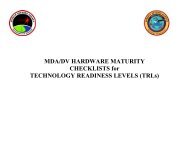bmdo technologies for biomedical applications - MDA Technology
bmdo technologies for biomedical applications - MDA Technology
bmdo technologies for biomedical applications - MDA Technology
Create successful ePaper yourself
Turn your PDF publications into a flip-book with our unique Google optimized e-Paper software.
66MEMS SENSOR FOR BALANCEDISORDERS• The lightweight MEMS sensor maysomeday act as a cue to patients withinner-ear disorders.BMDO HISTORYThe Charles Stark Draper Laboratories (Cambridge, MA) developed amicromachining process <strong>for</strong> the manufacture of miniature inertial sensorsusing microelectromechanical systems (MEMS). The low-cost sensorscombined the functions of a gyroscope and an accelerometer with an in<strong>for</strong>mationprocessor to provide inertial guidance components <strong>for</strong> BMDO’sLightweight Exoatmospheric AdvancedProjectiles program. The lightweight sensorshave numerous <strong>applications</strong> in militaryVestibular disease can beand commercial technology, including precision-guidedmunitions, autopilot con-detected by observingrhythmic movements of trols, airbag deployment, and medical electronics.In this last category, the micromachininginnovation may lead to a uniquethe eyes while instillingway to help patients with balance disorders.warm or cool water intoHOW IT WORKSthe ears. In a normal Draper Labs’ micromachining process usescontrolled chemical etching that can placesubject, cool water causes up to 10,000 devices on a single siliconchip. The chips can be mass-produced,the eyes to move in thekeeping production costs to a minimum. Inaddition, the low power requirements, smallopposite direction of thesize, and complexity of the chip make it airrigated ear, and warm versatile component <strong>for</strong> a lightweight feedbacksystem. The chip’s features have lentwater causes movement themselves well to a collaborative projectinvolving the restoration of balance cues totoward it. The clinician can patients with inner-ear disturbances.judge certain aspects of MEDICAL SIGNIFICANCEVestibular (inner-ear) disorder is an uncommonbut sometimes very debilitating condi-disease by watching howtion that can be caused by transient viralfast or how slowly theinfections, tumors, or trauma to thevestibular organs and nerves. Signals abouteye movements occurthe body’s orientation in space (particularlyrotational changes) are processed by a systemof hair cells that are moved about byand whether movement issuppressed in a particular fluid flow within the inner ear’s semicircularcanals. These signals are relayed by thedirection.vestibular nerves to the brain, which in turnsignals the body to make postural adjustmentsto maintain balance. Damage to theChapter 3 - Intervention TechnologiesSection A - ImplantsBMDO Technologies <strong>for</strong> Biomedical Applications




